Improvement In Food Resources Short Answer Questions
Question1. What are the differences between mixed cropping and intercropping ?
Answer:
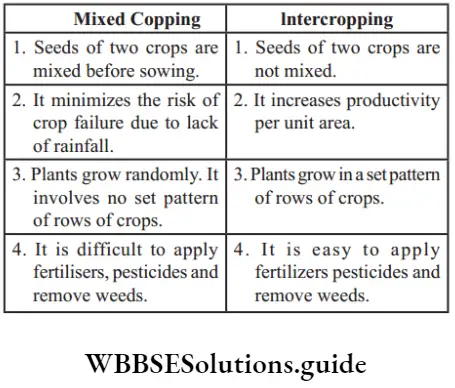
Read And Learn More: NEET Class 9 Biology Short Question And Answers
Question 2. What are the advantages ofusing manures in the crop filds?
Answer:
Advantages ofusing manures in the crop filds are:
- They improve fertility of the soil by providing mineral nutrients to the soil.
- Improve soil texture by adding organic matter to the soil. Organic matter increases water-holding capacity of sandy soil. It improves drainage in clayey soil by preventing water logging.
- Use of organic manure helps in recycling of farm waste, saving the environment from excessive use of fertilizers.
- They provide food for soil organisms, which keep the soil in a healthy, balanced condition.
- Manures do not cost anything to the farmer as he prepares it from the farmyard wastes.
NEET Biology Class 9 Improvement in Food Resources Short Questions
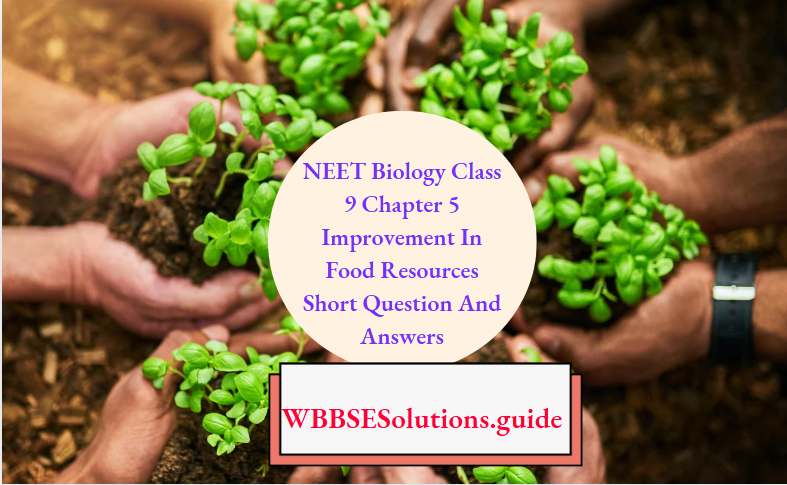
Question 3. What are the differences between broilers and layers and in their management ?
Answer:
Differences between broilers and layers and in their management are:
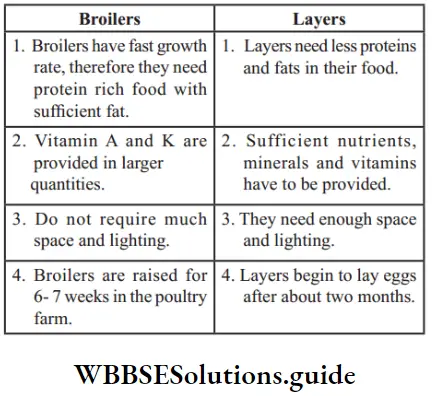
Short Answer Questions on Improvement in Food Resources for NEET Exam
Question 4. Why is use of excess fertilizer determental for environment?
Answer:
Use of excess fertilizers will cause:
- Mineral loading of underground water.
- Excess minerals in the crop plants.
- Salination of soil.
- Run off from fertilizers rich soil, will cause eutrophication of water bodies.
Improvement in Food Resources NEET Short Questions and Answers
Question 5. What are micronutrients?
Answer: The mineral elements required by plants in trace or micro amounts are called micronutrients. They are iron, manganese, boron, zinc, copper, molybdenum and chlorine.
Question 6. What is plant tissue culture? What are the important steps involved in it?
Answer: The growth of plant tissues in an artificial environment (or culture medium) outside the parent organism (in vitro) is called tissue culture. It involves the following important steps:
- Removal of tissues from parent organism.
- Inoculation of explant (excised tissue) in suitable culture medium.
- Incubation of excised tissues in a conducive environment.
- Maintenance of culture for future use.
Question 7. Some ofthe high yielding varieties ofcrops are Ganga-101, Sonara-64, Pusa-205, Jaya, Arjuna,
- Which of these represents wheat?
- Which of these represents rice?
- Which of these represent maize?
Answer:
- Wheat-Sonora-64, Arjuna.
- Rice-Pusa-205, Jaya
- Maize-Ganga-101
Question 8. Distinguish between
- Inland fishery and marine fishery
- Culture fishery and capture fishery
- Aquaculture and pisciculture
Answer:
- Inland fihery is the rearing of fih in freshwater whereas marine fihery is the rearing of fih in sea water.
- Culture fihery is the raising offih in ponds and tanks whereas capturing vis management of catching of fih without raising them.
- Aquaculture is rearing andmanagementoffih, oysters, mussels and other aquatic animals and plants. The pisciculture is rearing, catching and management of catching offih
Question 9. What type ofinsect pests are found in our crop filds? Name any three of them.
Answer: Harmful creatures for our crop plants are small insects which attack the plants in three ways :
- Chewing insect : Insect pests of this category cut the root, stem and leaf with the help of their chewing mouthparts. They chew and swallow these pieces of plant parts. Examples, Grasshoppers, Caterpillars, Locusts, etc.
- Sucking insects : These insects puncture the plant parts and suck the cell sap with the help of their needle like hollow beaks. Examples, Leaf hoppers, Aphids, Bugs, etc.
- Internal feeders : These insects bore into stem and fruits. They live inside the plant parts and harm the crop yield. Examples, Weevils, Borers, etc.
NEET Biology Improvement in Food Resources Important Short Questions
Question 10. How do plants get nutrients?
Answer: Plants obtain nutrients from air, water and soil. Air is the source of carbon and oxygen. Hydrogen is obtained from water. The remaining thirteen elements are got directly from soil through root absorption.
Question 11. What is the inflence ofbreeding in milk production?
Answer: The quality and quantity of milk of some breeds is comparatively much better than others. For example, exotic or foreign breeds of cattle have long lactation periods and give more amount of milk. Jersey cows (Native of Island of Jersey, U.S.A.) and Brown Swiss cows (Native ofSwitzerland) produce on an average 60 litres ofmilk in a day. On the other hand, local breeds (for example, Red Sindhi and Sahiwal) produce on an average only 6-8 litres of milk per day. Milk of Red Sindhi cow contains higher fat than those of Holstien (Native of Holand) and Brown Swiss).
Question 12. What do you mean by the following ?
- Green revolution
- White revolution
- Blue revolution
- Yellow revolution
Answer:
- Green revolution: Revolution in the increase of food grains (especially wheat)
- White revolution: Revolution in the increase of milk
- Blue revolution : Revolution in fih production
- Yellow revolution: Revolution in production of oil seeds.
Question 13. What would happen if poultry birds are larger in size and have no summer adaptation capacity? In order to get small sized poultry birds having summer adaptability, what method will be employed?
Answer: Larger sized birds require more feed. Summer adaptation is connected with egg laying. Little summer adaptation reduces egg laying. In order to obtain small sized poultry birds having summer adaptability, it is desirable to
- Either introduce the required exotic birds from outside and
- Cross-breed the local birds with exotic birds from outside.
- Small-sized birds are preferred for
- Lower requirement of feed
- Higher egg-laying capacity
- Lower requirement for space.
Best Short Questions for Class 9 Biology Improvement in Food Resources
Question 14. What is Organic farming?
Answer: It is the farming in which no chemical fertilizers, pesticides or herbicides are used. But uses of all organic matter for its growth like manure, seem leaves as pesticides, grain storage.
Question 15. State the difference between manure and fertilizer.
Answer:
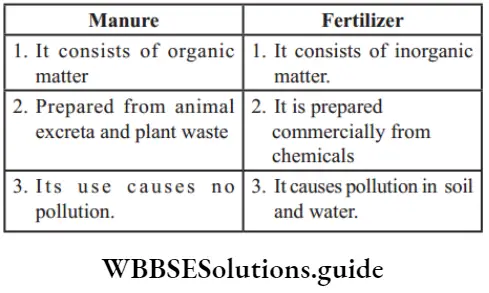
Question 16. Name a few varieties of bees used for commercial honey production.
Answer:
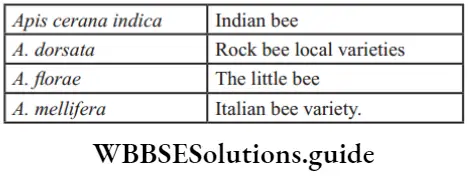
Improvement in Food Resources Class 9 NEET One-Liner Questions
Question 17. How are crops useful to us? What do they provide?
Answer: Crops provide us food for our daily body nutrient carbohydrates for energy requirement-like cereals such as wheat, rice, and maize.
Protein for bodybuilding: Pulses like grams, lentils.
Fats for energy – mustard, sunflower Vitamin, and minerals – from vegetables, spices and fruits.
Fodder crops – for livestock.
Question 18. What are the new variety traits obtained by cross-breeding of Indian and exotic Qbreeds of poultry?
Answer: The cross-breeding of Indian and exotic breeds for variety improvement and getting
The following traits.
- Number and quality of chicks.
- Dwarf broiler parent for commercial chick production.
- Summer adaptation capacity/tolerance to high temperature.
- Low maintenance requirements.
- Reduction in the size of the egg-laying bird with the ability to utilize more fibrous cheaper diets formulated using agricultural by-products.
Question 19. What are fertilizers? Excess use of fertilizers is not advisable. Explain.
Answer: Fertilizers are obtained artificially on commercial basis. It is a chemical which contains the nutrients required for the crop to grow. Fertilizers supply various nutrients as they are nutrient specifi example.-Urea provides-Nitrogen. Mixed fertilizer provides any two mixture of nutrients. They are expensive but the use yield large production hence are a factor of high-cost farming. Excessive use of fertilizers are not advisable as :
- It leads to soil and water pollution.
- It can destroy the fertility of soil. As the soil is not replenished, micro-organisms in the soil are harmed by fertilizers.
Question 20. Name the sources and the nutrients supplied by them to the plants.
Answer:
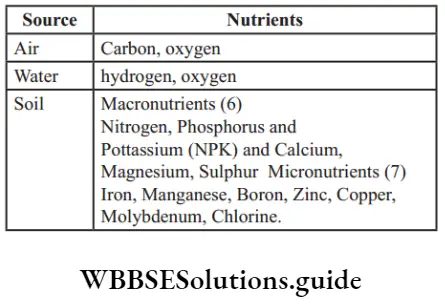
NEET Biology Class 9 Chapter 5 Short Answer Type Questions with Solutions
Question 21. How do insects pests attack the plant and affect it?
Answer: Insect pests attack the plants in three ways:
- They cut the root, stem and leaf.
- They suck the cell-sap from various parts of the plant and.
- They bore into stem and fruits. This way they affect the health of the crop and reduce yields.
Question 22. What are the factors for which variety improvement of crop is done?
Answer:
- Higher Yield: It helps in the production of crop.
- Biotic and Abiotic Resistance: Crop should be resistant to biotic factors like diseases, insects, pests and abiotic factor like drought, salinity, heat, cold, frost and water logging.
- Change in maturity Duration: Short-duration maturity allows farmer to grow more crops in a year and reduces the cost of crop production.
- Wider Adaptability: Crop should be able to adapt to changing environmental conditions.
- Desirable agronomic Characteristics: The tallness and dwarfness of crop. Dwarfness required for cereals, so that less nutrients are consumed
Question 23. What do you mean by exotic fihes? Name three important exotic fihes that are being cultured in India.
Answer: A number offih species have been imported from foreign countries and introduced into Indian fresh water for culture. Since, these fihes are not the natives ofthis country, they are called as exotic fihes. The three important exotic fihes used as food fih are :
- Common carp
- Silver carp
- Grass carp
Question 24. What do you mean by animal husbandry? Mention the important aspects of this branch of science.
Answer: Animal husbandry is the branch of agriculture that deals with the rearing, feeding, breeding, improvement and caring of domesticated animals.
The important aspects of animal husbandry are :
- Providing proper shelter to animals
- Providing proper food to animals
- Taking care of animals against diseases
- Using proper breeding technique for breed improvement.
Question 25. There are four varieties of poultry birds: Aseel, White Leghorn, Busra and Rhode Island Red. Which are indigenous and which are exotic? What would be the advantage of crossing indigenous species with exotic ones?
Answer: Indigenous varieties are Aseel and Busra; Exotic varieties are White Leghorn and Rhode Island Red. By crossing indigenous and exotic breeds, improved quality of commercial egg-laying and more flsh-producing birds can be produced.
NEET Study Material for Improvement in Food Resources with Short Q&A
Question 26. “If we use pesticides excessively in order to safeguard the crop from blight, it may cause long term damage to mankind”. Justify the statement.
Answer: Excessive and indiscriminate use of pesticides causes air, water and soil pollution and adversely affects human beings. The pesticides are either inhaled or taken through food and drinks. They accumualte in the body and may get biologically magnifid with time as they pass through the food chain. Pesticides have been reported to induce cancer, growth of tumours and have mutagenic effect in man.
Question 27. ‘The production of food from animal sources has increased greatly in the last few decades’. Justify it.
Answer: The ever increasing human population and the consequent decrease in agricultural land has compelled us to move towards animal husbandry to obtain food from animal sources. The last few decades have seen an enormous rise in animal meat production and by-products. Poultry, fiheries, piggery cattle, sheep and goat farming have developed considerable. Through operation flood and the silver revolution, milk and egg production have registered a record increase.
Question 28. A farmer was advised not to use a particular type of fertiliser for his crop after harvesting a crop of peas. Give one reason for such an advice. Name any two crops other than pea which would have shown the same effect.
Answer: Nitrogen fiing symbiotic bacteria (e.g. Rhizobium) remain associated with the root nodules of pea plant. These bacteria enrich the soil with ammonia and nitrate necessary for plant growth. Hence, a farmer need not use nitrogenous fertilisers in the fild after harvesting a crop of peas. Besides peas, gram (chana) and green pea (moong) also show the same effect.
Question 29. What are biofertilizers? In what sense are they better than chemical fertilizers?
Answer: Some microorganisms like nitrogen fixing bacteria, cyanobacteria, fungi and other microflra harbour near the roots of plant inside soil. They enrich the soil with nutrients and improve soil fertility, hence are collectively called as biofertilisers.
Question 30. What factors may be responsible for loss of grains during storage?
Answer: Both biotic and abiotic factors are responsible for the loss of stored grains. Abiotic factors include improper temperature of store house, humidity of air and high moisture content of the grains. Improper containers used for storage also cause loss of grains. Biotic factors include insect infusion, mites, birds, rodents, diseases caused by microorganisms and enzymatic actions occuring within food grains.
Improvement in Food Resources Class 9 NCERT Short Question Bank
Question 31. Name any two plantation crops and two commercial crops.
Answer:
- Plantation crop – tea, coffee.
- Commercial crops – cotton, jute
Question 32. What are the different systems of irrigation?
Answer: Some common irrigation systems are dug wells, tube wells, canal system river lift system and tanks
Question 33. Write the name of one indigenous and one foreign breed of poultry bird.
Answer:
- Indigenous breed : Aseel
- Foreign breed: Leghorn
